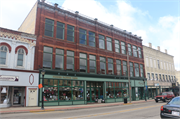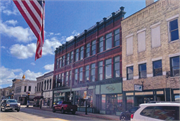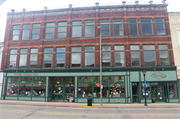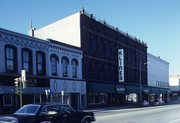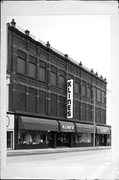Property Record
207-213 E MAIN ST
Architecture and History Inventory
| Historic Name: | George Schempf Building; Kusel Hardware |
|---|---|
| Other Name: | S.S. Kresge Co.; Kline's Clothing Store |
| Contributing: | Yes |
| Reference Number: | 7181 |
| Location (Address): | 207-213 E MAIN ST |
|---|---|
| County: | Jefferson |
| City: | Watertown |
| Township/Village: | |
| Unincorporated Community: | |
| Town: | |
| Range: | |
| Direction: | |
| Section: | |
| Quarter Section: | |
| Quarter/Quarter Section: |
| Year Built: | 1855 |
|---|---|
| Additions: | C. 1905C. 1866C. 1864 |
| Survey Date: | 19862020 |
| Historic Use: | retail building |
| Architectural Style: | Neoclassical/Beaux Arts |
| Structural System: | |
| Wall Material: | Brick |
| Architect: | |
| Other Buildings On Site: | |
| Demolished?: | No |
| Demolished Date: |
| National/State Register Listing Name: | Main Street Commercial Historic District |
|---|---|
| National Register Listing Date: | 6/2/1989 |
| National Register Multiple Property Name: |
| Additional Information: | This large three-story brick block was created during a remodeling project between 1901 and 1909 under the ownership of the Schempf family using the original three-story, two-story building constructed for George Schempf in 1855 (209-211 E. Main), the three-story former Kusel Hardware building built c. 1866 at 207 E. Main and the two-story Schempf building built c. 1864 at 213 E. Main. Continuing to use the 19th century style of the older building, the facade of the remodeled Schempf building is divided vertically by capped brick pilasters and horizontally by brick panels and flat stone window lintels linked by stone belt courses. A small dentil trimming projecting molding or cornice and a frieze ornamented by classical styled swag designs decorates the top of the building. Rectangular brick batterments topped by pendants and iron cresting extends above the roof line. Characterized by cream brick side and rear elevation, the Schempf building has a small rear addition. The twelve-bay facade has been altered by the removal of the original window frames, now filled in with bricks and wood panels. In addition, the storefront, although generally in keeping with the building, has been remodelled in a contemporary manner. Pressed metal ceilings remain in the otherwise remodeled interior. The Schempf Block is important as an example of vernacular architecture influenced by the Victorian Gothic style. Enlarged and remodeled at various times in the later part of the 19th century, and again in the early 20th century, the red brick Schempf Block exhibits the biochromatic exterior associated with the Victorian Gothic style. Ornamental cresting, battlements and pressed classical designs on the frieze enliven the surface in the medieval manner. The Schempf Block is the only extant building in the proposed Main Street Commercial District to show the polychromatic characteristics if the Victorian Gothic style, although some of the painted brick commercial building originally may also have had similar characteristics. Originally built as a two-store building by George Schempf in 1855, the Schempf Block is comprised of four stores that were combined by the early 20th century into one business block known as the Schempf Brothers Department Store. This is the Schempf's Block, constructed in the mid-1800s and added to later in the century. Eventually, Schempf's Block contained four retail parts in its store. In two parts was the Schempf Brothers department store which existed until 1936. In one part was the branch store of the Kusel Hardware business, whose main store was at 108-110 W. Main St. (demolished). Kusel was here until around 1889. At that time the hardware business was taken over by Henry Winkenwerder, a relative by marriage of the Kusels. Winkenwerder stayed here until at least 1930. In the fourth part of the building was the W.D. Sproesser jewelry store. He left around 1910 for a new location and Schempfs took over this storefront to enlarge their department store. In the upstairs of this building was Schempf's Hall, an important meeting place for a number of groups, particularly fraternal groups such as the Odd Fellows. Schempfs stayed in business until 1936, but today the building still houses a department store: Kline's Department Store. This building is significant for local history under National Register criterion A because it was the home to one of the largest and longest department or dry goods store in the city. Schempf's Block had, within its wall, probably three of the most significant retail businesses in the city. Schempf's store was a leader in "modern" retailing in the community. Their department store heralded the new era in merchandizing of having many different types of goods in smaller departments, all under the same roof. The store had a profound effect on the makeup of Main Street, as Schempf's Block dominated the streetscape with its size and purposed. The Kusel store would ordinarily have littel significance if their main store was still extant. However, it recently fell to the wrecking ball. The Kusel Hardware Store was to hardware what Schempf's was to dry goods. It was THE most successful hardware business in the community. Because their main store is no longer extant, this location of Kusel's branch store heps make this building significant. The fact that the Kusel store became the Winkenwerder hardware store, another long-term and successful hardware business further bolsters the building's significance. Finally, the W.D. Sproesser jewelry store that was located here was also a significant business. And William Sproesser had an economic effect outside of the commercial district as an investor in industries in the community. The location of his business in this prominent building also speaks to its significance. While the Schempf's Block is individually significant for local history, it also contributes to the overall development of commerce in the Main Street historic district. |
|---|---|
| Bibliographic References: | (A) Watertown City Directories, 1866-1930, Watertown Public Library. (B) Tax Records, City of Watertown, 1860-1910, Area Research Center, Library, University of Wisconsin-Whitewater. (C) Watertown Democrat March 6, 1856. (D) Sanborn-Perris Insurance Maps 1884, 1895, 1900, 1915. |
| Wisconsin Architecture and History Inventory, State Historic Preservation Office, Wisconsin Historical Society, Madison, Wisconsin |

